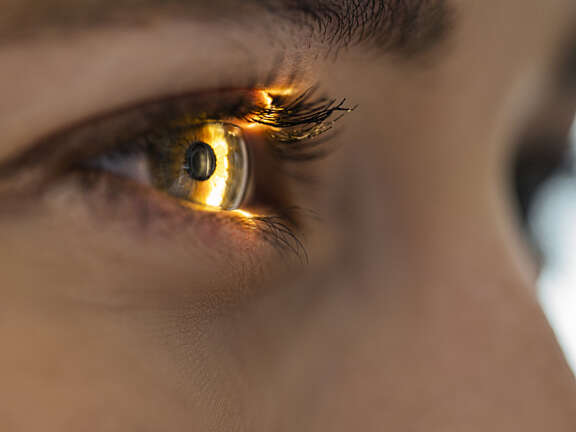Diabetic Retinopathy: How to Protect Your Vision


If you have type 2 diabetes, you’re not alone. Of the 34 million people in the U.S. with diabetes, nearly 95% have type 2—and that number has risen steadily over the past few decades.
One of the most devastating complications of diabetes is diabetic retinopathy. It affects between 28.5% to 40.3% of people in the U.S. with type 2 diabetes. If left untreated, it can lead to serious vision issues and even blindness.
Understanding diabetic retinopathy can help you to safeguard your eyesight.
What Is Diabetic Retinopathy?
Imagine your retinas as tiny “movie screens” in the backs of your eyes where images form. When you look at something, light enters your eye and lands on the retina, which then sends a signal to your brain, telling you what you’re seeing.
Persistently high blood sugar can harm the blood vessels in your retinas. If left unchecked, this can lead to the leaking of fluid or blood into your retinas and even complete blockages.
Diabetic Retinopathy Stages
Diabetic retinopathy typically progresses through four stages:
- Mild Nonproliferative Diabetic Retinopathy: In this early stage, small blood vessels in the retina may leak fluid or blood. Signs are often subtle, and you may not notice any changes to your vision.
- Moderate Nonproliferative Retinopathy: At this stage, more severe blockages in retinal blood vessels can occur, reducing blood flow. Additionally, areas deprived of oxygen may produce new, weaker blood vessels. Most people will still not notice any changes to their vision.
- Severe Nonproliferative Retinopathy: As diabetic retinopathy progresses; blood vessel damage continues. Left unchecked, it can lead to a greater risk of noticeable vision loss.
- Proliferative Diabetic Retinopathy: In this advanced stage, new blood vessels begin to grow on the surface of the retinas or into the vitreous gel, a clear substance that fills the eye. This can lead to blurred vision, floaters, and even vision loss.
Can Diabetic Retinopathy Be Prevented?
While preventing diabetic retinopathy entirely may not always be possible, you can take steps to reduce your risk and slow its progression:
- Control blood sugar levels: Keeping your blood sugar levels in the healthy range can help to prevent or delay the onset of diabetic retinopathy.
- Avoid hypertension: High blood pressure (hypertension) can strain blood vessels throughout your body, including those in your eyes.
- Manage cholesterol: Elevated cholesterol levels can lead to fatty deposit buildup in blood vessels, narrowing them and reducing blood flow to the retinas.
- Maintain a healthy lifestyle: Eating well, managing your weight, staying active, and not smoking can protect your eye health and help prevent risk factors for diabetic retinopathy.
What to Expect in a Diabetic Eye Exam
Regular eye exams are crucial for people with diabetes. During a diabetic eye exam, your eye doctor will do different tests to make sure everything is okay, including:
- Checking your visual acuity: Using an eye chart, your doctor will determine how well you can see at various distances.
- Performing a dilated eye exam: Your doctor will use special eye drops to make your pupils bigger. This will help them get a good look at the back of your eyes to check the retina and optic nerve for signs of diabetic retinopathy.
- Measuring eye pressure: High eye pressure levels could point to other eye conditions, such as glaucoma. Your doctor will check that pressure is normal.
- Performing retinal imaging: Using a high-powered imaging device, your doctor will look closely at your retina. This helps them to see even tiny changes that might happen over time.
- Measuring macular thickness: The macula is a very important part of your retina, helping you see things clearly. Using a special machine called an optical coherence tomography, your doctor will measure how thick it is. If it's too thick, it could be a sign of a problem called macular edema, where fluid builds up and affects your vision.
Since early detection and treatment of diabetic retinopathy is important, the American Diabetes Association recommends getting a diabetic eye exam as soon as you’re diagnosed with type 2 diabetes. Then, your doctor will want to see you every one or two years—and more frequently if vision issues are detected.
Can Diabetic Retinopathy Be Reversed?
While there is no cure for diabetic retinopathy, there are several treatment options that can help to preserve your vision. Some of these include:
- Laser therapy: Using specialized lasers, your doctor can help to seal leaking blood vessels and reduce abnormal blood vessel growth in the retinas.
- Intraocular injections: Injecting anti-vascular endothelial growth factor (VEGF) medications into the eye can help to decrease swelling and inhibit the growth of abnormal blood vessels.
- Pneumatic retinopexy: With this procedure, the doctor injects a gas bubble into the eye to push the retina back into place if retinal detachment has occurred. Then, cryotherapy or laser therapy is used to seal any breaks or tears in the retina.
- Anti-inflammatory medications: Nonsteroidal anti-inflammatory drugs (NSAIDs) or other anti-inflammatory medications may be used to reduce inflammation and swelling in the eye.
- Vitrectomy: In cases of severe cases of diabetic retinopathy, surgery may be necessary to remove blood and scar tissue from the eye.
Be Proactive in Protecting Your Vision
With diabetic retinopathy, detecting problems early and getting timely treatments can slow its progression and reduce vision loss. If you have type 2 diabetes, you will want to prioritize your eye health by getting regular diabetic eye exams, taking steps to manage your blood sugar, and doing all you can to live a healthy lifestyle.
Your Innovista Medical Center provider can screen for this condition in office and refer you to a specialist if you have signs of diabetic retinopathy.
